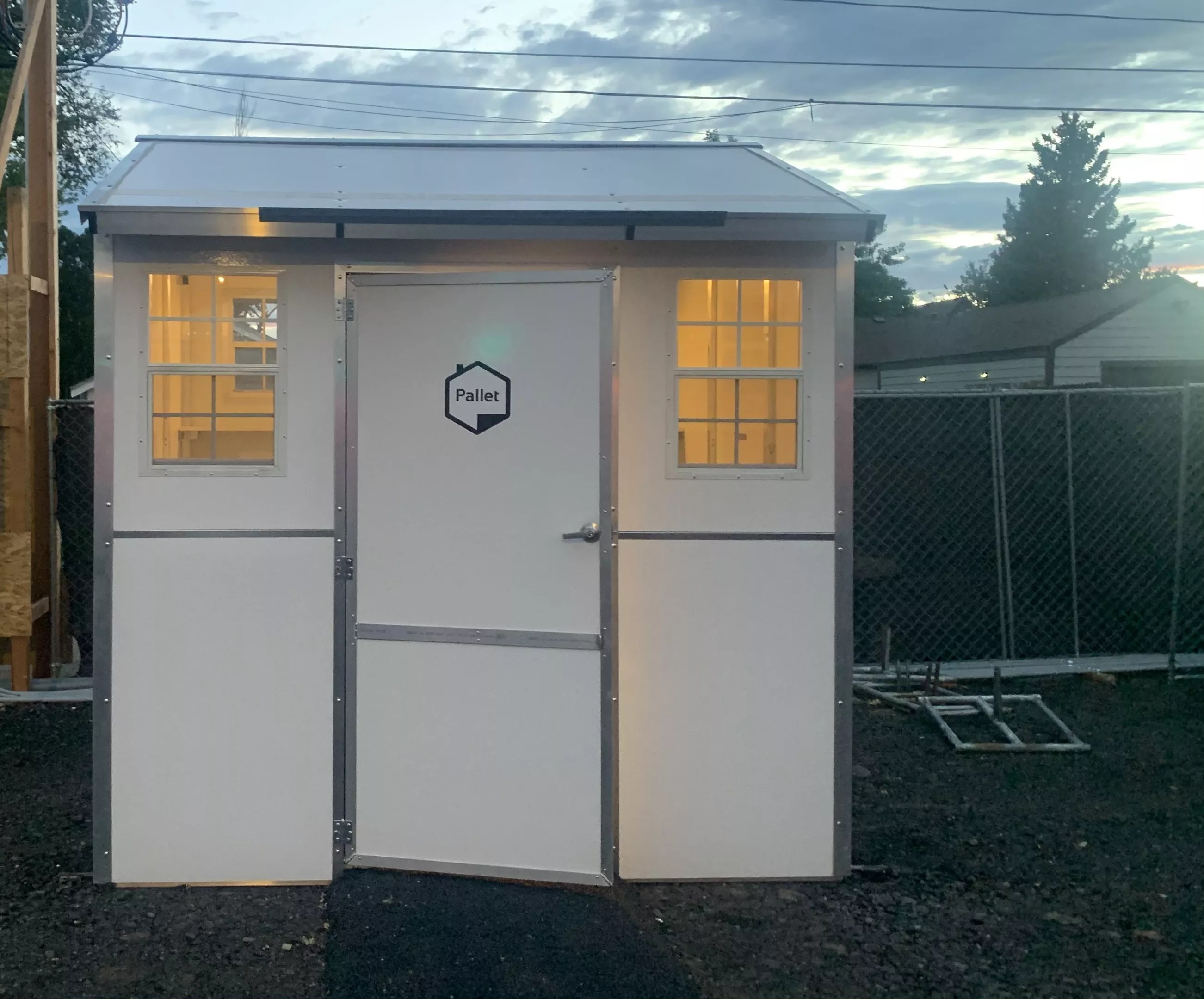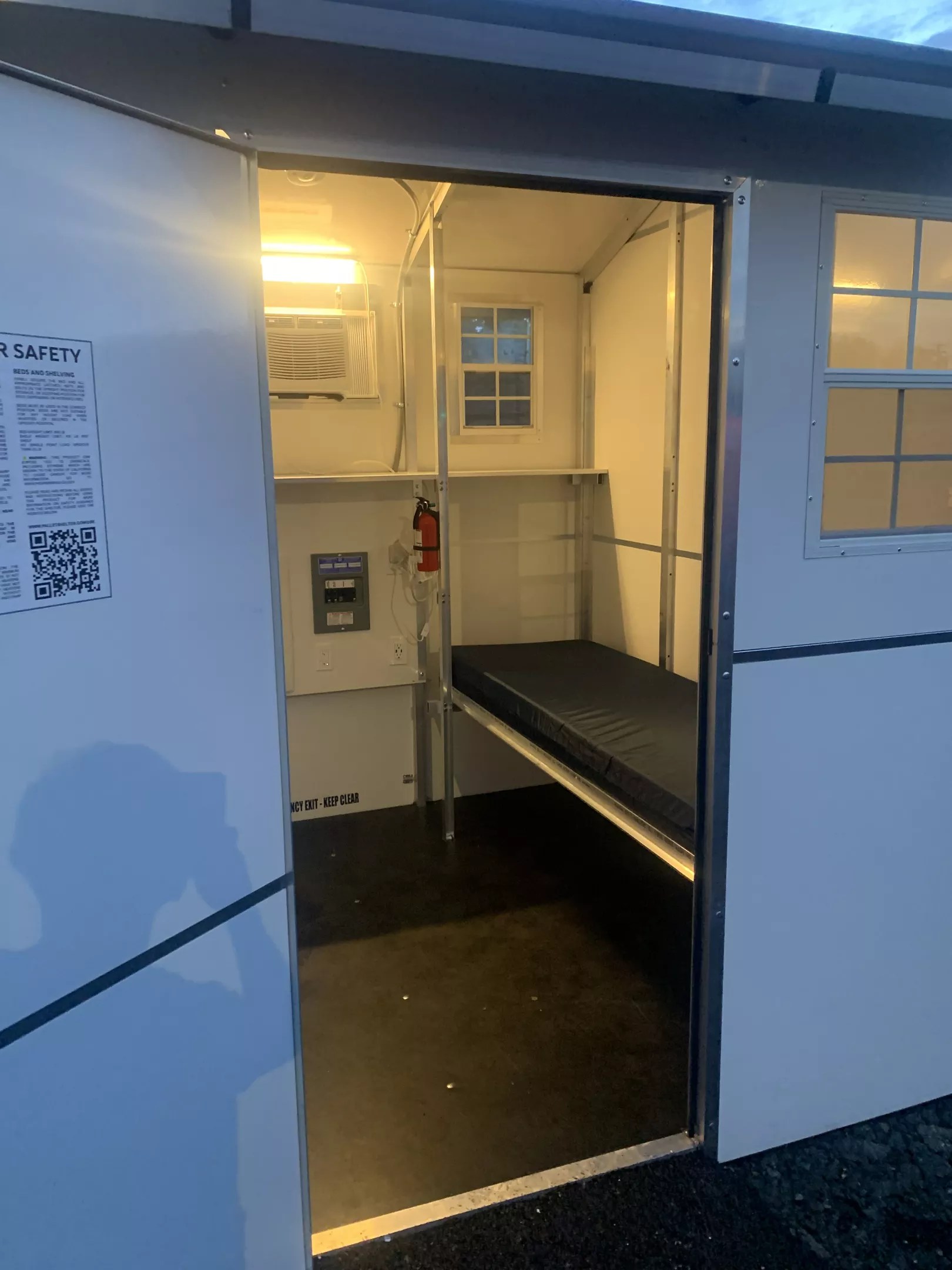
Conor McCormick-Cavanagh

Audio By Carbonatix
With residents set to move into a new safe-camping site at 221 Federal Boulevard on July 7, I took the opportunity to spend the night before in one of the site’s pallet shelters.
Crafted by Pallet, a company in Washington state, the shelter is made of pre-fabricated panels that are fairly easy to put together in an hour or two. The resulting structure can harbor people after natural disasters, as well as individuals experiencing homelessness. The one that I stayed in had a vaulted nine-foot ceiling, four windows, a bed with a mattress and a door that locked. It also had an air conditioner, a heater, a light and electrical outlets. Five of these pallet shelters are now set up at the new safe-camping site in Barnum run by the Colorado Village Collaborative and the St. Francis Center; there are also dozens of ice-fishing tents.

The door to the pallet shelter locks from the inside.
Conor McCormick-Cavanagh
After arriving around 7:30 p.m., I had a quick dinner at the nearby Columbine Steak House and Lounge, then toured the site with Ian Stitt, the St. Francis Center staffer who’s running the facility. Until now, he’d been leading operations at the safe-camping site on Regis University’s campus, whose lease just ran out. Many of the Regis camp residents are now moving over to the Barnum site.
Stitt showed me around the place, which includes a large modular unit with food and supplies as well as multiple porta-potties and sinks. One of the draws of the safe-camping sites is their centralized access to sanitation and services. But the showers had not yet arrived.
I was assigned the pallet shelter closest to the entrance of the site, which is located on an empty plot of land, now covered in gravel, that the St. Francis Center plans to eventually turn into affordable housing. I set my sleeping bag and pillow on top of the mattress, brushed my teeth using one of the outdoor sinks, got into the sleeping bag and listened to the last few innings of the Rockies-Dodgers game on my phone.

Each pallet shelter comes with a bed and mattress.
Conor McCormick-Cavanagh
The shelter was a nice place to rest my head: spacious enough, secure since I could lock it from the inside, and not too warm or cold, as I was able to open the windows. I didn’t use the heater or air conditioner.
My experience in the pallet shelter definitely contrasted with my night in one of the ice-fishing tents at the safe-camping site next to the Denver Community Church at 16th Avenue and Pearl Street back in December 2020. Snow was falling that night and temperatures dipped close to 20 degrees. The tent had a heating pad on the floor, which didn’t seem to be doing much; the CVC, which was running the site, provided me with a heated blanket that helped me stay warm inside my own sleeping bag, one that was good to 35 degrees. I could see my breath while I watched Monday Night Football on my phone, and I woke up a few times in the night, feeling chilled.
That was Denver’s second safe-camping site, which would open the next day; the first one had welcomed residents just a few days earlier. The program has proved so popular that there have been at least a couple of safe-camping sites open in the city ever since, and Denver City Council approved allotting close to $4 million to the program in 2022. The goal is to house around 370 people in a total of four sites, including this one. In 2021, service providers were able to help transition 47 people from the sites into more stable housing.
In the pallet shelter, the temperature was certainly not the issue. Since I had the windows open, the sound of vehicles driving by on Federal Boulevard was somewhat disturbing, but I could have closed the windows and run the air-conditioning instead. I also wasn’t a fan of the mattress, and that coupled with the noise prevented me from getting a good night’s sleep.

The pallet shelters sit next to dozens of ice-fishing tents.
Conor McCormick-Cavanagh
At the same time, I realized that I had many amenities not typically afforded to people sleeping in tents, tarps or sleeping bags on the streets of Denver. Since I could lock the door, I felt secure knowing that no one could walk into my shelter; my belongings were safe. And I also was able to use a nearby porta-potty in the middle of the night without worrying about a neighbor yelling at me or a cop handing me a ticket. I just did my business and went back to my bed.
Most important, having some personal space was liberating. I could be alone and relax. I could stay up as late or go to bed as early as I wanted. I didn’t have to move my bag in the morning, and could have left it there while I went to work.
That natural attraction to personal space is one reason that some people shelter in tents on the streets rather than go into the Denver shelter system, where personal space beyond a mattress is not always available.
Tents cost around $400, while the tiny homes run around $25,000. At $8,500, the pallet shelters fall in between. But it’s hard to put a price on a safe place to call home.